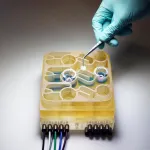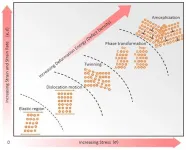COVID-19 pandemic led to decreased school meal access for children in need across Maryland
Despite best efforts to distribute free meals, study notes was a 58 percent drop in number of meals provided to children in need
2021-01-29
(Press-News.org) School closures during COVID-19 have decreased access to school meals, which is likely to increase the risk for food insecurity among children in Maryland, according to a new report issued by researchers at the University of Maryland School of Medicine (UMSOM). The number of meals served to school-age children during the first three months of the pandemic dropped by 58 percent, compared to the number of free or reduced-price meals served the previous spring. As a result, thousands of children across the state were placed at increased risk of food insecurity, with many likely experiencing the health ramifications associated with the abrupt disruption in their access to regular meals.
"Food insecurity in children is associated with poor child health, low developmental and academic performance, and may co-occur with excess weight gain.," said study leader Erin Hager, PhD, Associate Professor of Pediatrics and Epidemiology & Public Health at UMSOM. "We found that despite the best efforts of food service providers across the state to ensure access to free meals during the pandemic, they were not able to reach every family in need. We need to learn more about what we can do to overcome these access challenges."
Dr. Hager and her colleagues worked with the Maryland State Department of Education (who funded this study), local school systems in the state, and food service providers to evaluate meal distribution during the first three months of the pandemic. During this time, and even now, all meals distributed are free to children under 18 years. They found that certain policies worked well to ensure access to free meals, including temporary waivers issued by Federal and State governments to enable flexibility in policies normally in place to support subsidized meals.
For example, families did not have to prove that their incomes were below a certain level in order to gain access to the meals. They could also pick up multiple meals and multiple days of food for their children during a single excursion.
"Leaders of the school meal programs throughout the state chose to place meal distribution sites in areas where the need was greatest," said Dr. Hager, "which we found to be very helpful for access." The staff who worked at these meal distribution sites reported in surveys and interviews that they were deeply concerned about not reaching enough children in need and worried about children going hungry during the unprecedented school closures.
Financial resources remained a concern for the leaders of the meal program. After examining the financial data, the researchers concluded that, without significant local, state, and federal support, the financial health of these programs will take a major hit during the pandemic, when revenues are greatly reduced and expenses have grown.
"The COVID-19 pandemic has exacerbated the crisis of food insecurity in our nation's children," said E. Albert Reece, MD, PhD, MBA, Executive Vice President for Medical Affairs, UM Baltimore; the John Z. and Akiko K. Bowers Distinguished Professor; and Dean, University of Maryland School of Medicine. "We need to take a hard look at the lessons learned from this study to determine long-term solutions for providing meals to students when school is regularly not in session, including summer months and holidays."
INFORMATION:
About the University of Maryland School of Medicine
Now in its third century, the University of Maryland School of Medicine was chartered in 1807 as the first public medical school in the United States. It continues today as one of the fastest growing, top-tier biomedical research enterprises in the world -- with 45 academic departments, centers, institutes, and programs; and a faculty of more than 3,000 physicians, scientists, and allied health professionals, including members of the National Academy of Medicine and the National Academy of Sciences, and a distinguished two-time winner of the Albert E. Lasker Award in Medical Research. With an operating budget of more than $1.2 billion, the School of Medicine works closely in partnership with the University of Maryland Medical Center and Medical System to provide research-intensive, academic and clinically based care for nearly 2 million patients each year. The School of Medicine has more than $563 million in extramural funding, with most of its academic departments highly ranked among all medical schools in the nation in research funding. As one of the seven professional schools that make up the University of Maryland, Baltimore campus, the School of Medicine has a total population of nearly 9,000 faculty and staff, including 2,500 student trainees, residents, and fellows. The combined School of Medicine and Medical System ("University of Maryland Medicine") has an annual budget of nearly $6 billion and an economic impact more than $15 billion on the state and local community. The School of Medicine, which ranks as the 8th highest among public medical schools in research productivity, is an innovator in translational medicine, with 600 active patents and 24 start-up companies. The School of Medicine works locally, nationally, and globally, with research and treatment facilities in 36 countries around the world. Visit medschool.umaryland.edu
[Attachments] See images for this press release:

ELSE PRESS RELEASES FROM THIS DATE:
2021-01-29
Boulder, Colo., USA: GSA's dynamic online journal, Geosphere, posts articles online regularly. Topics for articles posted for Geosphere this month include feldspar recycling in Yosemite National Park; the Ragged Mountain Fault, Alaska; the Khao Khwang Fold and Thrust Belt, Thailand; the northern Sierra Nevada; and the Queen Charlotte Fault.
Feldspar recycling across magma mush bodies during the voluminous Half Dome and Cathedral Peak stages of the Tuolumne intrusive complex, Yosemite National Park, California, USA
Louis F. Oppenheim; Valbone Memeti; Calvin G. Barnes; Melissa Chambers; Joachim Krause ...
Abstract: Incremental pluton growth can produce sheeted complexes with no magma-magma interaction or large, dynamic magma bodies communicating via crystal and melt exchanges, depending ...
2021-01-29
Washington, DC — Blood pressure that remains elevated over of time — known as chronic hypertension — has been linked to heart disease, which is the leading cause of death in the United States. Recent research has shown that persistent high blood pressure may also increase the risk for stroke and overall mortality. Yet, only about 1 in 4 adults with chronic hypertension have their condition under control, according to the Centers for Disease Control and Prevention.
In a new study to be presented today at the Society for Maternal-Fetal Medicine's (SMFM) annual meeting, The Pregnancy Meeting™, researchers from the University of Pittsburgh will unveil findings that suggest that women who develop high blood pressure during pregnancy and who continue ...
2021-01-29
News reports indicate COVID-19 vaccines are not getting out soon enough nor in adequate supplies to most regions, but there may be a larger underlying problem than shortages. A University of California, Davis, study found that more than a third of people nationwide are either unlikely or at least hesitant to get a COVID-19 vaccine when it becomes available to them.
The results are from public polling of more than 800 English-speaking adults nationwide in a study published online earlier this month in the journal Vaccine.
"Our research indicates that vaccine uptake will be suboptimal ... with 14.8 percent of respondents being unlikely to get vaccinated ...
2021-01-29
WOODS HOLE, Mass. -- The most powerful substance in the human brain for neuronal communication is glutamate. It is by far the most abundant, and it's implicated in all kinds of operations. Among the most amazing is the slow restructuring of neural networks due to learning and memory acquisition, a process called synaptic plasticity. Glutamate is also of deep clinical interest: After stroke or brain injury and in neurodegenerative disease, glutamate can accumulate to toxic levels outside of neurons and damage or kill them.
Shigeki Watanabe of Johns Hopkins University School of Medicine, a familiar face at the Marine Biological Laboratory (MBL) as a faculty member and researcher, is hot on the ...
2021-01-29
RIVERSIDE, Calif. -- When we step on the car brake upon seeing a red traffic light ahead, a sequence of events unfolds in the brain at lightning speed.
The image of the traffic light is transferred from our eyes to the visual cortex, which, in turn, communicates to the premotor cortex -- a section of the brain involved in preparing and executing limb movements. A signal is then sent to our foot to step on the brake. However, brain region that helps the body go from "seeing" to "stepping" is still a mystery, frustrating neuroscientists and psychologists.
To unpack this "black box," a team of neuroscientists at the University of California, Riverside, has ...
2021-01-29
A new report combining forecasting and expert prediction data, predicts that 125,000 lives could be saved by the end of 2021 if 50% or more of the U.S. population initiated COVID vaccination by March 1, 2021.
"Meta and consensus forecast of COVID-19 targets," developed by Thomas McAndrew, a computational scientist and faculty member at Lehigh University's College of Health, and colleagues, incorporates data from experts and trained forecasters, combining their predictions into a single consensus forecast. In addition McAndrew and his team produce a metaforecast, which is a combination of an ensemble of computational models and their consensus forecast.
In addition to predictions related to the impact of vaccinations, ...
2021-01-29
Researchers at Linköping University, Sweden, have developed a proton trap that makes organic electronic ion pumps more precise when delivering drugs. The new technique may reduce drug side effects, and in the long term, ion pumps may help patients with symptoms of neurological diseases for which effective treatments are not available. The results have been published in Science Advances.
Approximately 6% of the world's population suffer from neurological diseases such as epilepsy, Parkinson's disease, and chronic pain. However, currently available drug delivery methods - mainly tablets and injections - place the drug in locations where it is not required. This can lead to side effects ...
2021-01-29
CAMBRIDGE, MA -- In many ways, our brain and our digestive tract are deeply connected. Feeling nervous may lead to physical pain in the stomach, while hunger signals from the gut make us feel irritable. Recent studies have even suggested that the bacteria living in our gut can influence some neurological diseases.
Modeling these complex interactions in animals such as mice is difficult to do, because their physiology is very different from humans'. To help researchers better understa nd the gut-brain axis, MIT researchers have developed an "organs-on-a-chip" system that replicates interactions between the brain, liver, and colon.
Using that system, the researchers were able to model the influence that microbes living in the gut have on both healthy brain tissue and tissue samples derived ...
2021-01-29
An international team of researchers produced islands of amorphous, non-crystalline material inside a class of new metal alloys known as high-entropy alloys.
This discovery opens the door to applications in everything from landing gears, to pipelines, to automobiles. The new materials could make these lighter, safer, and more energy efficient.
The team, which includes researchers from the University of California San Diego and Berkeley, as well as Carnegie Mellon University and University of Oxford, details their findings in the Jan. 29 issue of Science Advances.
"These present ...
2021-01-29
In 2017, the Nobel Prize in Physiology or Medicine went to three scientists who uncovered the molecular mechanisms that control the circadian rhythm, otherwise known as the "wake-sleep" cycle. To carry out their work, the scientists used the common fruit fly Drosophila melanogaster, making this the sixth Nobel to be awarded to research involving it.
Fruitful fruit flies
Life scientists have been using Drosophila for over a century now. First proposed by entomologist Charles W. Woodworth as a model organism, its use in research was pioneered by geneticist Thomas H. Morgan who ran his famous ...
LAST 30 PRESS RELEASES:
[Press-News.org] COVID-19 pandemic led to decreased school meal access for children in need across Maryland
Despite best efforts to distribute free meals, study notes was a 58 percent drop in number of meals provided to children in need





